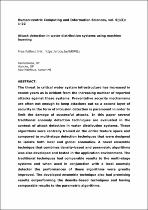JavaScript is disabled for your browser. Some features of this site may not work without it.
- ResearchSpace
- →
- Research Publications/Outputs
- →
- Journal Articles
- →
- View Item
| dc.contributor.author |
Ramotsoela, DT

|
|
| dc.contributor.author |
Hancke, GP

|
|
| dc.contributor.author |
Abu-Mahfouz, Adnan MI

|
|
| dc.date.accessioned | 2019-09-26T10:55:48Z | |
| dc.date.available | 2019-09-26T10:55:48Z | |
| dc.date.issued | 2019-04 | |
| dc.identifier.citation | Ramotsoela, D.T., Hancke, G.P. and Abu-Mahfouz, A.M.I. 2019. Attack detection in water distribution systems using machine learning. Human-centric Computing and Information Sciences, vol. 9(13): 1-22 | en_US |
| dc.identifier.issn | 2192-1962 | |
| dc.identifier.uri | https://link.springer.com/article/10.1186/s13673-019-0175-8 | |
| dc.identifier.uri | https://doi.org/10.1186/s13673-019-0175-8 | |
| dc.identifier.uri | https://rdcu.be/bRWGz | |
| dc.identifier.uri | http://hdl.handle.net/10204/11138 | |
| dc.description | Copyright: Springer 2019. Due to copyright restrictions, the attached PDF file only contains the abstract of the full text item. For access to the full text item, please consult the publisher's website: https://doi.org/10.1186/s13673-019-0175-8. A free fulltext non-print version of the article can be viewed at https://rdcu.be/bRWGz | en_US |
| dc.description.abstract | The threat to critical water system infrastructure has increased in recent years as is evident from the increasing number of reported attacks against these systems. Preventative security mechanisms are often not enough to keep attackers out so a second layer of security in the form of intrusion detection is paramount in order to limit the damage of successful attacks. In this paper several traditional anomaly detection techniques are evaluated in the context of attack detection in water distribution systems. These algorithms were centrally trained on the entire feature space and compared to multi-stage detection techniques that were designed to isolate both local and global anomalies. A novel ensemble technique that combines density-based and parametric algorithms was also developed and tested in the application environment. The traditional techniques had comparable results to the multi-stage systems and when used in conjunction with a local anomaly detector the performances of these algorithms were greatly improved. The developed ensemble technique also had promising results outperforming the density-based techniques and having comparable results to the parametric algorithms. | en_US |
| dc.language.iso | en | en_US |
| dc.publisher | Springer Nature | en_US |
| dc.relation.ispartofseries | Worklist;22666 | |
| dc.subject | Anomaly detection | en_US |
| dc.subject | Critical infrastructure | en_US |
| dc.subject | Cyber-physical systems | en_US |
| dc.subject | Machine learning | en_US |
| dc.subject | System security | en_US |
| dc.subject | Water monitoring | en_US |
| dc.title | Attack detection in water distribution systems using machine learning | en_US |
| dc.type | Article | en_US |
| dc.identifier.apacitation | Ramotsoela, D., Hancke, G., & Abu-Mahfouz, A. M. (2019). Attack detection in water distribution systems using machine learning. http://hdl.handle.net/10204/11138 | en_ZA |
| dc.identifier.chicagocitation | Ramotsoela, DT, GP Hancke, and Adnan MI Abu-Mahfouz "Attack detection in water distribution systems using machine learning." (2019) http://hdl.handle.net/10204/11138 | en_ZA |
| dc.identifier.vancouvercitation | Ramotsoela D, Hancke G, Abu-Mahfouz AM. Attack detection in water distribution systems using machine learning. 2019; http://hdl.handle.net/10204/11138. | en_ZA |
| dc.identifier.ris | TY - Article AU - Ramotsoela, DT AU - Hancke, GP AU - Abu-Mahfouz, Adnan MI AB - The threat to critical water system infrastructure has increased in recent years as is evident from the increasing number of reported attacks against these systems. Preventative security mechanisms are often not enough to keep attackers out so a second layer of security in the form of intrusion detection is paramount in order to limit the damage of successful attacks. In this paper several traditional anomaly detection techniques are evaluated in the context of attack detection in water distribution systems. These algorithms were centrally trained on the entire feature space and compared to multi-stage detection techniques that were designed to isolate both local and global anomalies. A novel ensemble technique that combines density-based and parametric algorithms was also developed and tested in the application environment. The traditional techniques had comparable results to the multi-stage systems and when used in conjunction with a local anomaly detector the performances of these algorithms were greatly improved. The developed ensemble technique also had promising results outperforming the density-based techniques and having comparable results to the parametric algorithms. DA - 2019-04 DB - ResearchSpace DP - CSIR KW - Anomaly detection KW - Critical infrastructure KW - Cyber-physical systems KW - Machine learning KW - System security KW - Water monitoring LK - https://researchspace.csir.co.za PY - 2019 SM - 2192-1962 T1 - Attack detection in water distribution systems using machine learning TI - Attack detection in water distribution systems using machine learning UR - http://hdl.handle.net/10204/11138 ER - | en_ZA |






